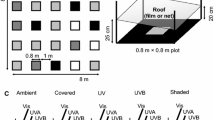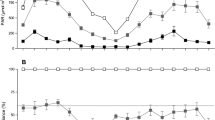Abstract
The effects of ultraviolet-B radiation on regeneration after disturbance of a natural sub-arctic heathland have been investigated. Areas of pristine dwarf shrub heath were denuded of all above ground biomass in 1992 and exposed to enhanced UV-B (simulating a 15% depletion of the ozone layer). The resulting regenerated stem and leaf growth parameters were measured after four years on three dwarf shrubs, Vaccinium myrtillus, V. uliginosum and V. vitis-idaea and the grass Calamagrostis lapponica; leaves of the three dwarf shrubs were also analysed for UV-absorbing compounds and carbohydrates. Regeneration irrespective of treatment was slow, with Empetrum hermaphroditum failing to regenerate at all. Vaccinium myrtillus showed the most rapid regeneration attaining much of its original biomass in four years. There was a significant interaction between UV-B and year of regeneration in V. myrtillus; annual stem length increment showed an initial stimulation of 75% under enhanced UV-B in the first year of regeneration while a reduction of 16% was observed in the fourth year. Both V. uliginosum and V. vitis-idaea showed a reduction in annual stem length increment as regeneration progressed with a greater than 50% reduction in stem increment in the fourth year of regeneration compared to the first. Vaccinium uliginosum also showed an initial reduction in stem length increment of 40% under enhanced UV-B. None of the species were affected by enhanced UV-B in terms of total regenerated stem and leaf biomass or UV-absorbing compounds in regenerated leaf tissue. Total leaf carbohydrate and the ethanol/water soluble fraction in V. uliginosum were significantly increased by 29% and 31% respectively under enhanced UV-B. This suggests either a stimulation of photosynthesis or a reduction in sink size for photo-assimilates. Results are discussed in the context of the extremely slow regeneration of sub-arctic heath communities and the implications of contrasting UV-B effects on the regenerative ability of different species.
Similar content being viewed by others
References
Bäch, L. 1987. Summary: Tourism and nature conservancy. Articles and discussions at the research seminar organised by Uppsala University and the Swedish Touring Club on October 29 1986. Acta Univ. Ups. C. Organisation och Historia 53: 137–140.
Bäch, L. & Bäch, E. 1986. Effecterna av vägbygge-väg 98 mellan Kiruna och Ricksgränsen. Acta Univ. Ups. C. Organisation och Historia 52: 167–176.
Balakumar, T., Vincent, V. H. B. & Paliwal, K. 1993. On the interaction of UV-B radiation (280–315 nm) with water stress in crop plants. Physiol. Plant. 87: 217–222.
Barsig, M., Schneider, K. & Gehrke, C. 1998. Effects of UVB radiation on fine structure, carbohydrates and pigments in Polytrichum commune. Bryologist. 101: 358–365.
Björn, L. O. & Murphy, T. M. 1985. Computer calculations of solar ultraviolet radiation at ground level. Physiol. Vég. 23: 555–561.
Björn, L. O. & Teramura, A. H. 1993. Simulation of daylight ultraviolet radiation and effects of ozone depletion. In: Young, A.R., Björn, L.O., Moan, J. & Nultsch (eds), Environmental UV Photobiology. Plenum Press, New York.
Björn, L. O., Callaghan, T. V., Johnsen, I., Lee, J. A., Manetas, Y., Paul, N. D., Sonesson, M., Wellburn, A. R., Coop, D., Heide-Jorgensen, H. S., Gehrke, C., Gwynn-Jones, D., Johanson, U., Kyparissis, Levizou, E., Nikolopoulus, D., Petropoulu, Y & Stephanou, M. 1997. The effects of UV-B radiation on European heathland species. Plant Ecol. 128: 252–264.
Borland, A. M. & Farrar, J. F. 1985. Diel patterns of carbohydrate metabolism in leaf blades and leaf sheaths of Poa annua L. and Poa × jemtlandica (Almql) Richt. New Phytol. 100: 519–531.
Caldwell, M. M. 1971. Solar UV radiation and the growth and development in higher plants. In: Giese, A.C. (ed.), Photophysiology.
Chapin III, F. S., McKendrick, J. D. & Johnson, D. A. 1986. Seasonal changes in carbon fractions in Alaskan tundra plants of differing growth forms: implications of herbivory. J. Ecol. 4: 707–731.
Crawford, R. M. M. (ed.). 1997. Disturbance and recovery in Arctic lands: an ecological perspective. Kluwer Academic Publishers, Dordrecht, The Netherlands.
Day, T. A. & Vogelmann, T. C. 1995. Alterations in photosynthesis and pigment distributions in pea leaves following UV-B exposure. Physiol. Plant. 94: 433–440.
Dubois, M., Giles, K. A., Hamilton, J. K., Rebus, P. A. & Smith, F. 1956. Colorimetric method for the determination of sugars and related compounds. Anal. Chem. 248: 3441–3445.
Emanuelsson, U. 1984. Ecological effects of grazing and trampling on mountain vegetation in northern Sweden. PhD thesis, University of Lund, Sweden.
Forbes, B. C. 1992. Tundra disturbance studies 1. Long-term effects of vehicles on species richness and biomass. Environ. Conserv. 19: 48–58.
Forbes, B. C. 1996. Plant communities of archaeological sites abandoned dwellings and trampled tundra in the Eastern Canadian Arctic-A multivariate-analysis. Arctic 49: 141–154.
Gehrke, C., Johnason, U., Björn, L. O., Callaghan, T. V. & Lee, J. A. 1996. Effects of enhanced ultraviolet-B radiation on terrestrial sub-arctic ecosystems and implications for interactions with increased atmospheric CO2. Ecol. Bull. 45: 192–203.
Grammatikopoulos, G., Karousou, R., Kokkini, S. & Manetas, Y. 1998. Differential effects of enhanced UV-B radiation on reproductive effort on two chemotypes of Mentha spicata under field conditions. Aust. J. Plant Physiol. 25: 345–351.
Gwynn-Jones, D., Lee, J. A. & Callaghan, T. V. 1997. Effects of enhanced UV-B radiation and elevated carbon dioxide concentrations on a sub-arctic forest heath ecosystem. Plant Ecol. 128: 242–249.
Gwynn-Jones, D. & Johanson, U. 1996. Growth and pigment production in two subarctic grass species under four different UV-B irradiation levels. Physiol. Plant. 97: 701–707.
Harper, K. A. & Kershaw, G. P. 1997. Soil characteristics of 48 year-old borrow pits and vehicle tracks in shrub tundra along the CANOL no 1 pipeline corridor, Northwest territories, Canada. Arct. Alp. Res 29: 105–111.
Hunt, J. E. & McNeil, D. L. 1998. Nitrogen status affects UV-B sensitivity of cucumber. Aus. J. Plant Physiol. 25: 79–86.
Johanson, U., Gehrke, C., Björn, L. O. & Callaghan, T. V. 1995b. The effects of enhanced UV-B radiation on the growth of dwarf shrubs in a Subarctic heathland-Funct. Ecol. 9: 713–719
Johanson, U., Gehrke, C., Björn, L. O., Callaghan, T. V. & Sonesson, M. 1995a. The effects of enhanced UV-B radiation on a sub-arctic heath ecosystem. Ambio 24: 106–111.
Kevan, P. G., Forbes, B. C., Kevan, S. M. & Behanpelletier, V. 1995. Vehicle tracks on high arctic tundra-their effects on soil vegetation and soil arthropods. J. Appl. Ecol. 32(3): 665–667.
McFarren, D. M., McAdam, J. H. & Montgomery, W. I. 1995. The impact of burning and grazing on Heathland plants and invertebrates in County Antrim. Biol. & Environ. 95B: 1–17.
Müller, R., Crutzen, P. J., Grooß, J.-U., Brühl, C., Russell III, J. M., Gernandt, H., McKenna, D. S. & Truck, A. F. 1997. Severe chemical ozone loss in the Arctic during the winter of 1995–96. Nature 389: 709–712.
Nogues, S., D. J. Allen, Morison, J. I. L. & Baker, N. R. 1998. Ultraviolet-B radiation effects on water relations, leaf development, and photosynthesis in droughted pea plants. Plant Physiol. 117: 173–181.
Parsons, A. N., Press, M. C., Wookey, P. A., Welker, J. M., Robinson, C. H., Callaghan, T. V. & Lee J. A. 1995. Growth responses of Calamagrostis lapponica to simulated environmental change in the Sub-arctic. Oikos 72: 61–66.
Parsons, A. N., Welker, J. M., Wookey, P. A., Press, M. C., Callaghan, T. V. & Lee, J. A. 1994. Growth responses of four Sub-arctic dwarf shrubs to simulated environmental change. J. Ecol. 82: 307–318.
Press, M. C., Potter, J. A., Burke, M. J. W., Callaghan, T. V. & Lee, J. A. 1998. Responses of a sub-Arctic dwarf shrub heath community to simulated environmental change. J. Ecol. 86: 315–327.
Rex, M., Harris, N. R. P., von der Gathen, P. et al. 1997. Prolonged stratospheric ozone loss in the 1995–96 Arctic winter. Nature 389: 835–838.
Robinson, C. H., Michelsen, A., Lee, J. A., Whitehead, S. J., Callaghan, T. V., Press, M. C. & Jonasson, S. 1997. Elevated atmospheric CO2 affects decomposition of Festuca vivipara (L) Sm litter and roots in experiments simulating environmental change in two contrasting environmental ecosystems. Global Change Biol. 3: 37–49.
Ros, J. & Tevini, M. 1995. Interaction of UV-radiation and IAA during growth of seedlings and hypocotyl segments of sunflower. J. Plant Physiol. 146: 295–302.
Sirois, L. & Payette, S. 1991. Reduced postfire tree regeneration along a boreal forest-tundra transect in northern Quebec. Ecology 72: 619–627.
Sonesson, M. & Lundberg, B. 1974. Late quaternary forest development of the Torneträsk area, North Sweden. 1. Structure of modern forest ecosystems. Oikos 25: 121–133.
Strandberg, B. 1997. Vegetation recovery following anthropogenic disturbance in Greenland. In: Crawford, R. W. W. (ed.), Disturbance and recovery in Arctic lands: an ecological perspective. Kluwer Academic Publishers, Dordrecht.
Stephanou, M. & Manetas, Y. 1997. The effects of season, exposure, enhanced UV-B radiation and water stress on leaf epicuticular and internal UV-B absorbing capacity of Cistus creticus: a Mediterranean field study. J. Exp. Bot. 48: 1977–1985.
Sullivan, J. H. & Teramura, A. H. 1990. Field study of the interaction between solar UV-B radiation and drought on photosynthesis and growth in soybean. Plant Physiol. 92: 141–146.
Sullivan, J. H. & Teramura, A. H. 1992. The effects of ultraviolet-B radiation on loblolly pine. Trees 6: 115–120.
Tenow, O. 1996. Hazards to mountain birch forest-Abisko in perspective. Ecol. Bull. 45: 104–114.
Tenow, O. & Byland, H. 1995. Recovery of a mountain birch forest after severe defoliation by Epirrita autumnata. Manuscript I. In: Long term interactions between the autumnal moth and mountain birch: the roles of resourses, competitors, natural enemies, and weather. PhD dissertation, H. Byland, Uppsala, Sweden.
Tosserams, M. & Rozema, J. 1995. Effects of ultraviolet-B radiation (UV-B) on growth and physiology of the dune grassland species Calamagrostis epigeios. Environ. Pollut. 89: 209–214.
Weih, M., Johanson, U. & Gwynn-Jones, D. 1998. Growth and nitrogen utilization of mountain birch (Betula pubescens ssp. tortousa) as affected by ultraviolet radiation (UV-A and UVB) under laboratory and outdoor conditions. Trees 12: 201–207.
Author information
Authors and Affiliations
Rights and permissions
About this article
Cite this article
Phoenix, G., Gwynn-Jones, D., Lee, J. et al. The impacts of UV-B radiation on the regeneration of a sub-arctic heath community. Plant Ecology 146, 67–75 (2000). https://doi.org/10.1023/A:1009839506658
Issue Date:
DOI: https://doi.org/10.1023/A:1009839506658




